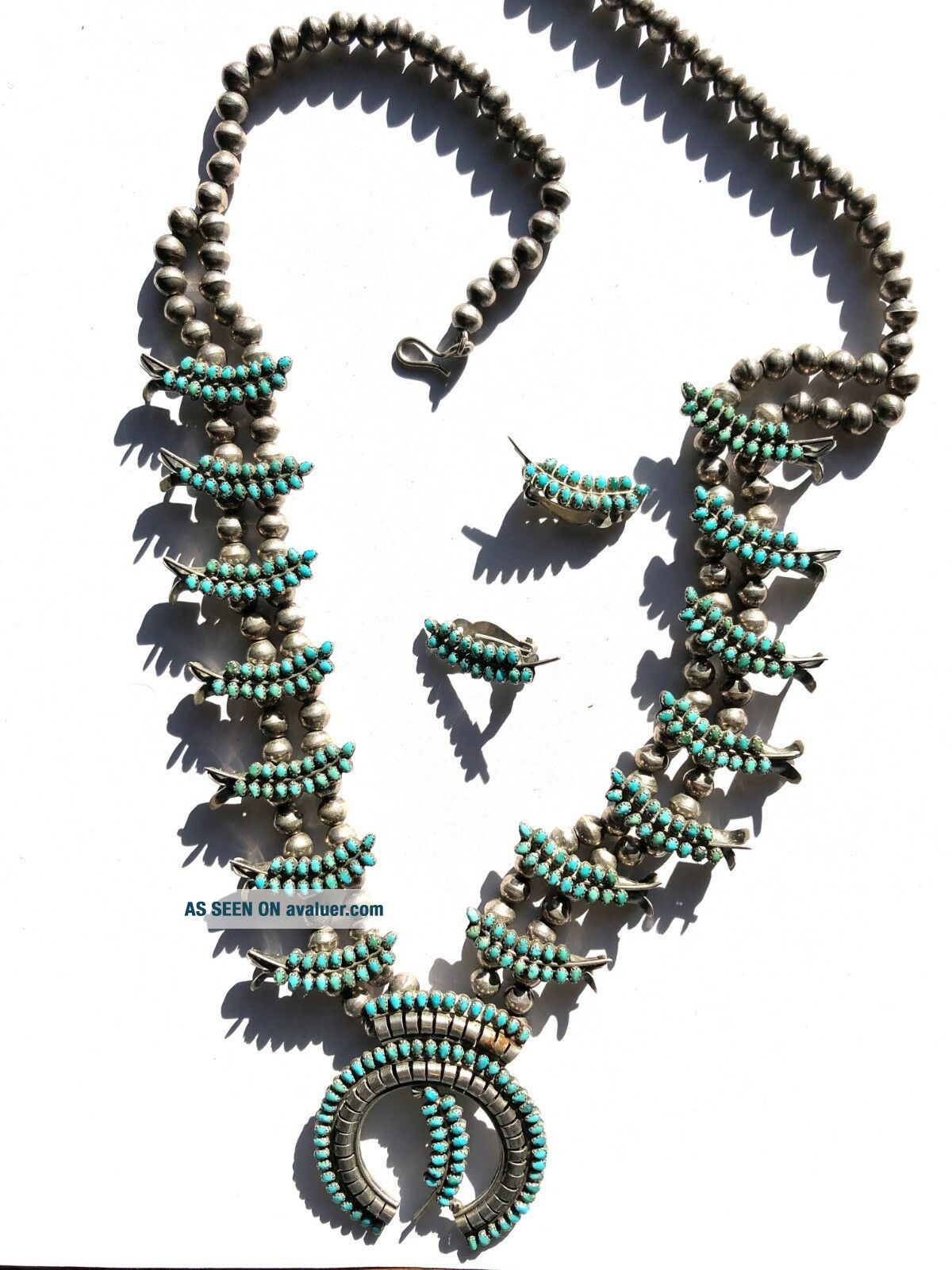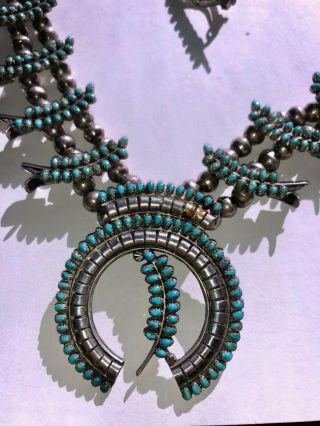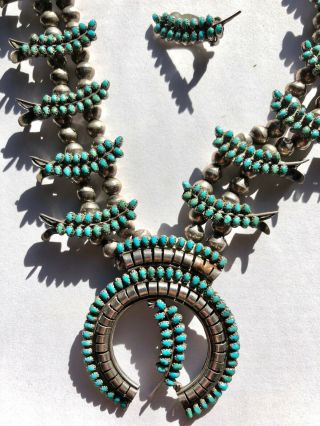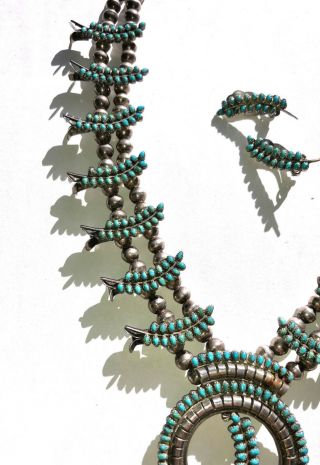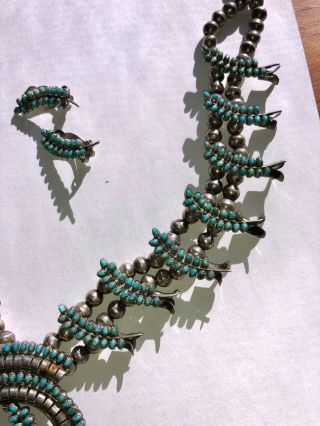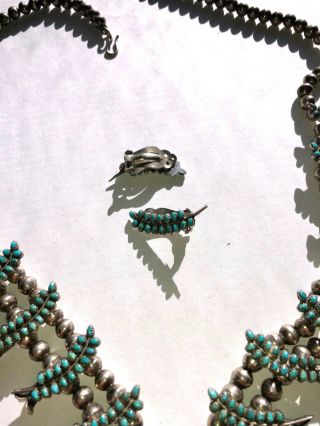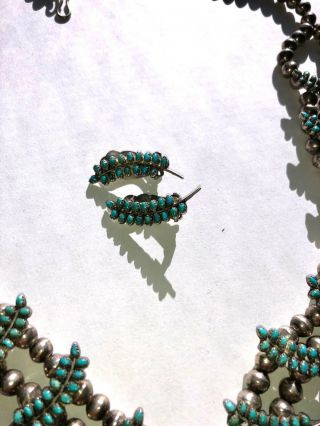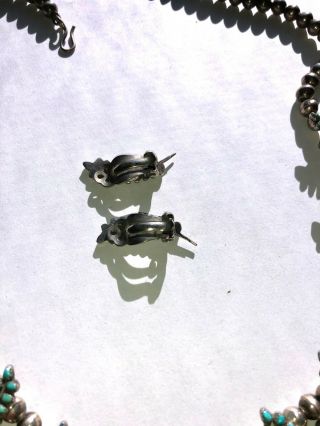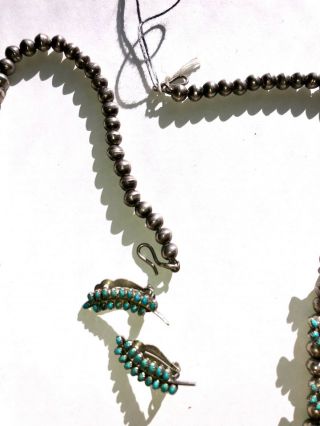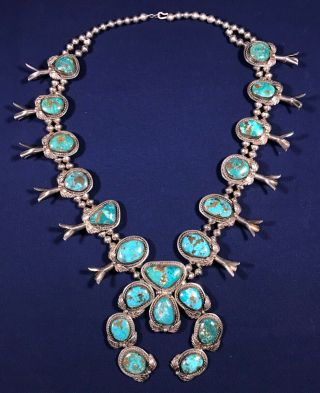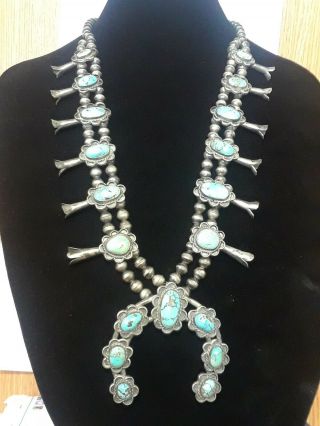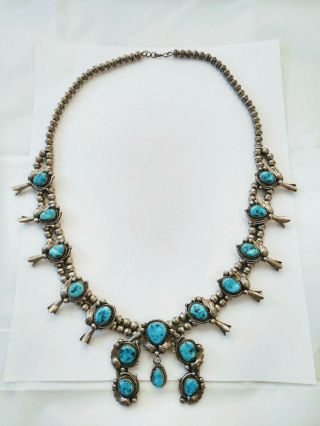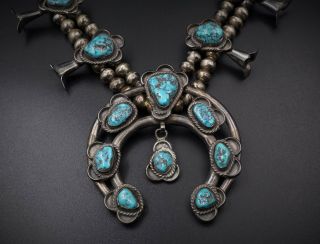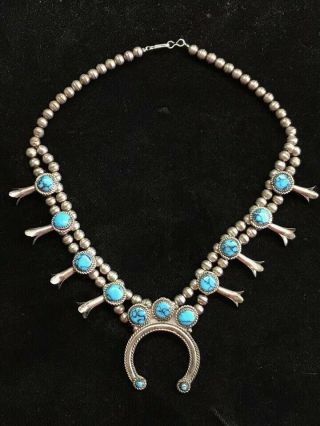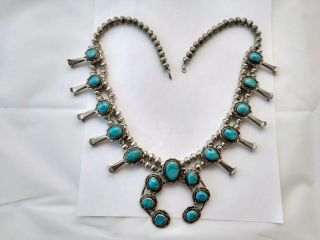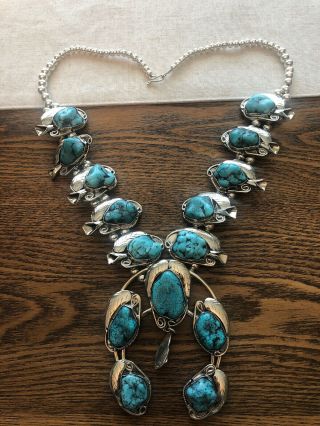Vintage NAVAJO Sterling Silver Turquoise Squash Blossom Necklace / Earring SET
Item History & Price
This is spectacular! A one-of-a-kind and seriously gorgeous 15" long Old Pawn Navajo STERLING SILVER and turquoise squash blossom NECKLACE AND EARRING SET was purchased in the early 1950s and had only one owner.
Shipping price includes insurance. Please email with questions.
INFO ABOUT OLD PAWN
"Old Pawn" : What Does it Mean?
A magical term in the Indian art world, “old pawn” is usually misapplied when spoken out of ignorance... of the cultural context to which it was originally assigned. Early trading post traders relied on their Navajo neighbors to be their best customers, as tools, rope, trade blankets, food, and general supplies were the primary products which the trader sold. Building a good customer base among the Navajo required the trader to become a trusted member of the community, and to do so, he often wore many hats. Settling disputes, loaning materials and money, providing shelter for Navajos traveling from distance, and even taking care of the body of a deceased Navajo whom no one claimed or wanted to deal with, were just some of the trader's responsibilities.
The pawning system was established and regulated under the BIA (Bureau of Indian Affairs), and provided that the trader could loan money on an item for 1 year during which time the owner could retrieve it for the loan amount plus 10%. The regulations also required the trader to tell the owner when the year was coming due, and, if the item was not reclaimed, the item went to dead pawn status, after which the trader than could sell the item to anyone. Nonetheless, it was usually in the trader's best interest not to sell items that went into dead pawn as to not offend the owner - as this would then hurt the trader's reputation in the community. In fact, most early pawn was never intended to “go dead and unclaimed, ” particularly as the loan was often for only a fraction of the item's value. For the Navajo, the items were placed in pawn for multiple reasons. Not only would you receive some quick cash or goods, but secondly, the items were pawned for safe-keeping in the owner's interest. This was a practical solution to the Navajo owner, who often moved with his sheep herd, and had few options as to where to hold valuables. In addition to being relatively safe, the jewelry was usually on display with its pawn ticket, and all the other Navajo patrons of the post could see the items, thereby raising the status of the owner.
Material wealth for the Navajo had traditionally been measured in animals and in blankets. The Navajo knew little of banks, and paper money had no value to them. When a wealthy Navajo (one with many sheep and goats) saw that the trader placed value on the silver jewelry, and that credit could be obtained with it, he began to commission local smiths usually paying in sheep or goats. The trader, preferring jewelry over animals, was more familiar with silver, and happy for a more versatile trade item; the smith was happy to increase his flocks, and the heavy weighted jewelry brought prestige to the owner and better credit from the trader. As the pawning system became established, jewelry took center stage as the item of choice to work with.
Often, Fred Harvey jewelry, made between 1910 and 1930, is referred to as "old pawn" jewelry (or at least placed within that category for dating purposes). However, reality is that the traders who catered only to the Navajo would not put the Fred Harvey style jewelry in their cases as the Navajo didn’t care for it. Consequently, most of the Fred Harvey jewelry was made and sold on or near the railroad which skirted the southern part of the reservation, and was not "pawned" for the various reasons aforementioned.
With the appearance of the automobile on the reservation in the 1930s, the northern part of the reservation, still heavy with old pawn, became the center of focus for museums and collectors to try to build collections of “old pawn” before it disappeared (as did all the old ways). Additionally, the traders, now seeing new tourists for the first time saw their dead pawn depleting, and, to replace stock, started buying some of the Harvey style jewelry. This was a win-win for the trader, as a Harvey piece sold to a tourist brought in money to the post, yet he was able to keep in favor with his local Navajo by not selling the dead pawn yet to be claimed. Over time, the Navajo, who began seeing the lighter weight, shiny Harvey jewelry, began to accept it more and more and incorporated it into their lives - although the heavy “Old Pawn” would always remain the prize.
Native American jewelry refers to items of personal adornment, whether for personal use, sale or as art; examples of which include necklaces, earrings, bracelets, rings and pins, as well as ketohs, wampum, and labrets, made by one of the Indigenous peoples of the United States. Native American jewelry normally reflects the cultural diversity and history of its makers, but tribal groups have often borrowed and copied designs and methods from other, neighboring tribes or nations with which they had trade, and this practice continues today. Native American tribes continue to develop distinct aesthetics rooted in their personal artistic visions and cultural traditions. Artists may create jewelry for adornment, ceremonies, and display, or for sale or trade. Lois Sherr Dubin writes, "[i]n the absence of written languages, adornment became an important element of Indian communication, conveying many levels of information." Later, jewelry and personal adornment "...signaled resistance to assimilation. It remains a major statement of tribal and individual identity."[2]Native American jewelry can be made from naturally occurring materials such as various metals, hardwoods, vegetal fibers, or precious and semi-precious gemstones; animal materials such as teeth, bones and hide; or man-made materials like beadworkand quillwork. Metalsmiths, beaders, carvers, and lapidaries combine these materials to create jewelry. Contemporary Native American jewelry ranges from hand-quarried and processed stones and shells to computer-fabricated steel and titanium jewelry.
Jewelry in the Americas has an ancient history. The earliest known examples of jewelry North American are four bone earrings founded at the Mead Site, near Fairbanks, Alaska that date back 12, 000 years.[3] Beginning as far back as 8800 BCE, Paleo-Indians in the American Southwest drilled and shaped multicolored stones and shells into beads and pendants.[4] Olivella shell beads, dating from 6000 BCE, were found in Nevada; bone, antler, and possibly marine shell beads from 7000 BCE were found in Russell Cave in Alabama; copper jewelry was traded from Lake Superior beginning in 3000 BCE; and stone beads were carved in Poverty Point in Louisiana in 1500 BCE.[5]Necklaces of heishe beads, or shell ground into flat discs, have been discovered in ancient ruins. Remnants of seashells that were used to make beads were also found. Oyster shell, mother of pearl, abalone, conch and clam shells have been important trade items in the Southwest for over a thousand years.Native beadwork continued to advance in the pre-Columbian era. Beads were made from hand-ground and filled turquoise, coral, and shell. Carved wood, animal bones, claws, and teeth were made into beads, which were then sewn onto clothing, or strung into necklaces.[6][7]Turquoise is one of the dominant materials of Southwestern Native American jewelry.Thousands of pieces were found in the Ancestral Pueblosites at Chaco Canyon. Some turquoise mines date back to Precolumbian times, and Ancestral Pueblo peoples traded the turquoise with Mesoamericans. Some turquoise found in southern Arizona dates back to 200 BCE.
The Navajo, or Diné, began working silver in the 19th century. Atsidi Sani, or "Old Smith" (c. 1828-1918), [48]who may have been the first Navajo blacksmith and is credited as the first Navajo silversmith, learned to work silver from a Mexican smith as early as 1853.[44][49] Navajo metalsmiths make buckles, bridles, buttons, rings, canteens, hollow beads, earrings, crescent-shaped pendants (called "najas"), bracelets, crosses, powder chargers, tobacco canteens, and disks, known as "conchas" or conchos" - typically used to decorate belts - made from copper, steel, iron, and most commonly, silver.Early Navajo smiths rocker-engraved, stamped, and filed designs into plain silver, melted from coins, flatware, and ingots obtained from European-American traders. Later, sheet silver and wire acquired from American settlers were also made into jewelry. The punches and stamps used by Mexican leather workers became the first tools used to create these decorations. Still later, railroad spurs, broken files, iron scraps and, later, piston rods became handmade stamps in the hands of these skilled artisans.[50] As commercially-made stamps became available however, through contact with the larger American economy, they were also utilized. Several other traditional hand tools are employed, being relatively simple to construct.The bellows consists of a skin bag about a foot long, held open with wooden hoops. It is provided with a valve and a nozzle. A forge, crucibles, an anvil, and tongs are used during the melting process. Molds, the matrix and die, cold chisels, scissors, pliers, files, awls, and emery paper also come into play. A soldering setup, consisting of a blowpipe and a torch made of oil-soaked rags used with borax, is manipulated by the smith. The silversmith uses a grinding stone, sandstone dust, and ashes for polishing the jewelry, and a salt called almogen is used for whitening. Navajo jewelers began sand casting silver around 1875; silver was melted and then poured into a mold, which would be carved from sandstone.[50] When cooled and set, the piece normally required additional filing and smoothing. Cast jewelry was also occasionally engraved. Sterling silver jewelry was soldered, and surrounded by scrolls, beads, and leaf patterns.Turquoise is closely associated with Navajo jewelry, but it was not until 1880 that the first turquoise was known to be set in silver. Turquoise became much more readily available in ensuing decades. Coral and other semi-precious stones came into common use around 1900.One of the most important forms of Navajo and Southwestern Native American jewelry, is the Squash Blossom Necklace. Most are made of a string of plain round silver beads, interspersed with more stylized "squash blossoms", and feature a pendant, or "naja", hung from the center of the strand. The squash blossom beads are copied from the buttons which held together the pants worn by the Spanish, and later, Mexican caballeros. These buttons represent - and are modeled after - pomegranates.[51][52][53] Their identification as "squash blossoms", which they closely resemble, is an understandable, and often repeated, error.[54] The naja, which resembles an upside-down horseshoe, completes the design. Their origin can be found a continent, and several hundred years away, as a traditional part of Spanish horse halters.[55][56][57]In 1903, anthropologist Uriah Hollister wrote about the Navajo; he said, "Belts and necklaces of silver are their pride... They are so skillful and patient in hammering and shaping that a fairly good-shaped teaspoon is often made of a silver dollar without melting and casting."
Shipping price includes insurance. Please email with questions.
INFO ABOUT OLD PAWN
"Old Pawn" : What Does it Mean?
A magical term in the Indian art world, “old pawn” is usually misapplied when spoken out of ignorance... of the cultural context to which it was originally assigned. Early trading post traders relied on their Navajo neighbors to be their best customers, as tools, rope, trade blankets, food, and general supplies were the primary products which the trader sold. Building a good customer base among the Navajo required the trader to become a trusted member of the community, and to do so, he often wore many hats. Settling disputes, loaning materials and money, providing shelter for Navajos traveling from distance, and even taking care of the body of a deceased Navajo whom no one claimed or wanted to deal with, were just some of the trader's responsibilities.
The pawning system was established and regulated under the BIA (Bureau of Indian Affairs), and provided that the trader could loan money on an item for 1 year during which time the owner could retrieve it for the loan amount plus 10%. The regulations also required the trader to tell the owner when the year was coming due, and, if the item was not reclaimed, the item went to dead pawn status, after which the trader than could sell the item to anyone. Nonetheless, it was usually in the trader's best interest not to sell items that went into dead pawn as to not offend the owner - as this would then hurt the trader's reputation in the community. In fact, most early pawn was never intended to “go dead and unclaimed, ” particularly as the loan was often for only a fraction of the item's value. For the Navajo, the items were placed in pawn for multiple reasons. Not only would you receive some quick cash or goods, but secondly, the items were pawned for safe-keeping in the owner's interest. This was a practical solution to the Navajo owner, who often moved with his sheep herd, and had few options as to where to hold valuables. In addition to being relatively safe, the jewelry was usually on display with its pawn ticket, and all the other Navajo patrons of the post could see the items, thereby raising the status of the owner.
Material wealth for the Navajo had traditionally been measured in animals and in blankets. The Navajo knew little of banks, and paper money had no value to them. When a wealthy Navajo (one with many sheep and goats) saw that the trader placed value on the silver jewelry, and that credit could be obtained with it, he began to commission local smiths usually paying in sheep or goats. The trader, preferring jewelry over animals, was more familiar with silver, and happy for a more versatile trade item; the smith was happy to increase his flocks, and the heavy weighted jewelry brought prestige to the owner and better credit from the trader. As the pawning system became established, jewelry took center stage as the item of choice to work with.
Often, Fred Harvey jewelry, made between 1910 and 1930, is referred to as "old pawn" jewelry (or at least placed within that category for dating purposes). However, reality is that the traders who catered only to the Navajo would not put the Fred Harvey style jewelry in their cases as the Navajo didn’t care for it. Consequently, most of the Fred Harvey jewelry was made and sold on or near the railroad which skirted the southern part of the reservation, and was not "pawned" for the various reasons aforementioned.
With the appearance of the automobile on the reservation in the 1930s, the northern part of the reservation, still heavy with old pawn, became the center of focus for museums and collectors to try to build collections of “old pawn” before it disappeared (as did all the old ways). Additionally, the traders, now seeing new tourists for the first time saw their dead pawn depleting, and, to replace stock, started buying some of the Harvey style jewelry. This was a win-win for the trader, as a Harvey piece sold to a tourist brought in money to the post, yet he was able to keep in favor with his local Navajo by not selling the dead pawn yet to be claimed. Over time, the Navajo, who began seeing the lighter weight, shiny Harvey jewelry, began to accept it more and more and incorporated it into their lives - although the heavy “Old Pawn” would always remain the prize.
Native American jewelry refers to items of personal adornment, whether for personal use, sale or as art; examples of which include necklaces, earrings, bracelets, rings and pins, as well as ketohs, wampum, and labrets, made by one of the Indigenous peoples of the United States. Native American jewelry normally reflects the cultural diversity and history of its makers, but tribal groups have often borrowed and copied designs and methods from other, neighboring tribes or nations with which they had trade, and this practice continues today. Native American tribes continue to develop distinct aesthetics rooted in their personal artistic visions and cultural traditions. Artists may create jewelry for adornment, ceremonies, and display, or for sale or trade. Lois Sherr Dubin writes, "[i]n the absence of written languages, adornment became an important element of Indian communication, conveying many levels of information." Later, jewelry and personal adornment "...signaled resistance to assimilation. It remains a major statement of tribal and individual identity."[2]Native American jewelry can be made from naturally occurring materials such as various metals, hardwoods, vegetal fibers, or precious and semi-precious gemstones; animal materials such as teeth, bones and hide; or man-made materials like beadworkand quillwork. Metalsmiths, beaders, carvers, and lapidaries combine these materials to create jewelry. Contemporary Native American jewelry ranges from hand-quarried and processed stones and shells to computer-fabricated steel and titanium jewelry.
Jewelry in the Americas has an ancient history. The earliest known examples of jewelry North American are four bone earrings founded at the Mead Site, near Fairbanks, Alaska that date back 12, 000 years.[3] Beginning as far back as 8800 BCE, Paleo-Indians in the American Southwest drilled and shaped multicolored stones and shells into beads and pendants.[4] Olivella shell beads, dating from 6000 BCE, were found in Nevada; bone, antler, and possibly marine shell beads from 7000 BCE were found in Russell Cave in Alabama; copper jewelry was traded from Lake Superior beginning in 3000 BCE; and stone beads were carved in Poverty Point in Louisiana in 1500 BCE.[5]Necklaces of heishe beads, or shell ground into flat discs, have been discovered in ancient ruins. Remnants of seashells that were used to make beads were also found. Oyster shell, mother of pearl, abalone, conch and clam shells have been important trade items in the Southwest for over a thousand years.Native beadwork continued to advance in the pre-Columbian era. Beads were made from hand-ground and filled turquoise, coral, and shell. Carved wood, animal bones, claws, and teeth were made into beads, which were then sewn onto clothing, or strung into necklaces.[6][7]Turquoise is one of the dominant materials of Southwestern Native American jewelry.Thousands of pieces were found in the Ancestral Pueblosites at Chaco Canyon. Some turquoise mines date back to Precolumbian times, and Ancestral Pueblo peoples traded the turquoise with Mesoamericans. Some turquoise found in southern Arizona dates back to 200 BCE.
The Navajo, or Diné, began working silver in the 19th century. Atsidi Sani, or "Old Smith" (c. 1828-1918), [48]who may have been the first Navajo blacksmith and is credited as the first Navajo silversmith, learned to work silver from a Mexican smith as early as 1853.[44][49] Navajo metalsmiths make buckles, bridles, buttons, rings, canteens, hollow beads, earrings, crescent-shaped pendants (called "najas"), bracelets, crosses, powder chargers, tobacco canteens, and disks, known as "conchas" or conchos" - typically used to decorate belts - made from copper, steel, iron, and most commonly, silver.Early Navajo smiths rocker-engraved, stamped, and filed designs into plain silver, melted from coins, flatware, and ingots obtained from European-American traders. Later, sheet silver and wire acquired from American settlers were also made into jewelry. The punches and stamps used by Mexican leather workers became the first tools used to create these decorations. Still later, railroad spurs, broken files, iron scraps and, later, piston rods became handmade stamps in the hands of these skilled artisans.[50] As commercially-made stamps became available however, through contact with the larger American economy, they were also utilized. Several other traditional hand tools are employed, being relatively simple to construct.The bellows consists of a skin bag about a foot long, held open with wooden hoops. It is provided with a valve and a nozzle. A forge, crucibles, an anvil, and tongs are used during the melting process. Molds, the matrix and die, cold chisels, scissors, pliers, files, awls, and emery paper also come into play. A soldering setup, consisting of a blowpipe and a torch made of oil-soaked rags used with borax, is manipulated by the smith. The silversmith uses a grinding stone, sandstone dust, and ashes for polishing the jewelry, and a salt called almogen is used for whitening. Navajo jewelers began sand casting silver around 1875; silver was melted and then poured into a mold, which would be carved from sandstone.[50] When cooled and set, the piece normally required additional filing and smoothing. Cast jewelry was also occasionally engraved. Sterling silver jewelry was soldered, and surrounded by scrolls, beads, and leaf patterns.Turquoise is closely associated with Navajo jewelry, but it was not until 1880 that the first turquoise was known to be set in silver. Turquoise became much more readily available in ensuing decades. Coral and other semi-precious stones came into common use around 1900.One of the most important forms of Navajo and Southwestern Native American jewelry, is the Squash Blossom Necklace. Most are made of a string of plain round silver beads, interspersed with more stylized "squash blossoms", and feature a pendant, or "naja", hung from the center of the strand. The squash blossom beads are copied from the buttons which held together the pants worn by the Spanish, and later, Mexican caballeros. These buttons represent - and are modeled after - pomegranates.[51][52][53] Their identification as "squash blossoms", which they closely resemble, is an understandable, and often repeated, error.[54] The naja, which resembles an upside-down horseshoe, completes the design. Their origin can be found a continent, and several hundred years away, as a traditional part of Spanish horse halters.[55][56][57]In 1903, anthropologist Uriah Hollister wrote about the Navajo; he said, "Belts and necklaces of silver are their pride... They are so skillful and patient in hammering and shaping that a fairly good-shaped teaspoon is often made of a silver dollar without melting and casting."



